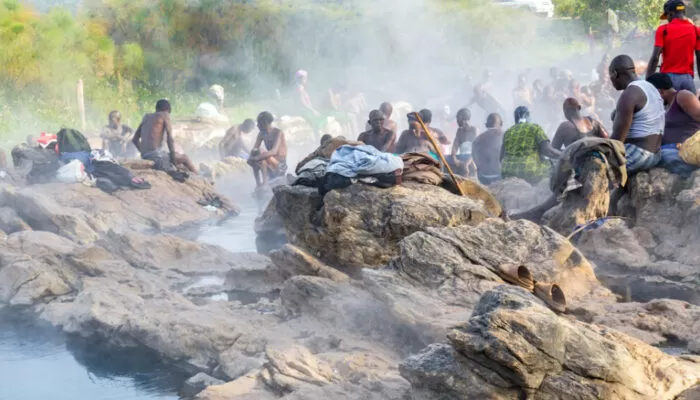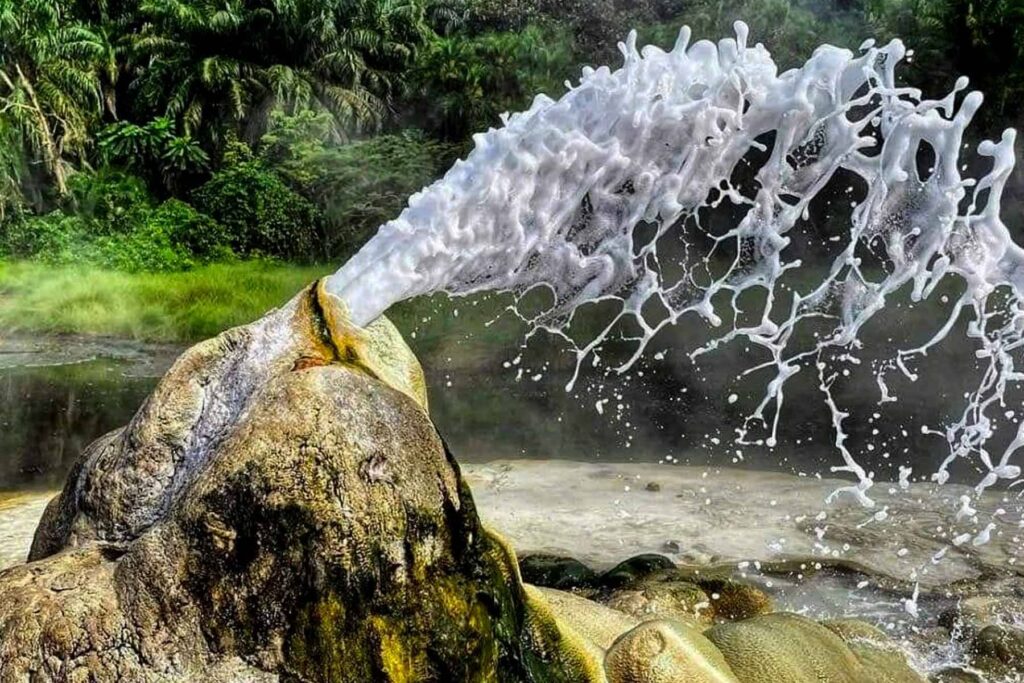Sempaya Hot Springs
Sempaya Hot Springs: The most remarkable sights in Semiliki National Park are the Sempaya Hot Springs, which are situated in the isolated western region of the Rwenzori Mountain Ranges in Bundibugyo district, on the edge of the vast Ituri forest that shares borders with both Uganda and the Democratic Republic of the Congo. These hot springs are the primary reason tourists come to Semiliki National Park on a Uganda Safaris tour since it offers a once-in-a-lifetime experience that is highly recommended.

One of the less frequented national parks, Semiliki is home to the biggest hot springs in Uganda and is the greatest spot for bird watching on Uganda Safaris trips, earning it the moniker “Birders Haven.” The Ituri forest of the Congo Basin, Africa’s oldest and most biodiverse forest, dominates the park, which is situated across the Semiliki valley. There are certain characteristics of central African catchments, not East African ones, in the Semiliki valley. The presence of ancient processes, such as hot springs that emerge from the depths to show the strong subterranean forces that have been sculpting the rift valley over the last 14 million years, makes it the only national park in Uganda that is primarily made up of lowland tropical forest and is densely populated with features that have accumulated for over 25,000 years. We call these hot springs Sempaya. Due to the difficulties experienced during the construction of the Fort Portal-Bundibugyo road along the ridges of the Rwenzori Mountain ranges, the name Sempaya was derived from the Swahili word “Sehemu mbaya,” which means “the difficult side.”
According to legend, there are two Sempaya hot springs: the male and female springs, which are located in separate places. Although scientists have a technical explanation for the hot springs’ beginnings, the indigenous Bamaga tribe, who live close to the hot springs in Semiliki National Park, have an intriguing tale of how the Sempaya hot springs came to be.

The hot springs for men
The native Bamaga people consider the male hot springs to be a sacred temple of the male gods, and they call them Mumbugu, despite the fact that tourists view them as tourist attractions. Wealth and sacrifices made by men to please the male gods in return for success are linked to the male hot springs. The Bamaga people think that the springs are only a historical formation. The chief of the Bamaga clan, Mzee Adonia Balinsanga, claims that the location of the male hot springs is historic. It is stated that when Bamaga women went to get firewood from the forest, they noticed a hairy guy wearing backclothes moving in a zigzag pattern across the area while brandishing a spear and a dog. The women hurried home to inform their husbands, who chose to pick him up, bring him to their houses, and then find him a local wife. The man who was found was eventually given the name Biteete, and he kept hunting, but he once went hunting and never came back. When the men of the village went to search for him after three days, they discovered just his spear and no signs of him or his dog. At this time, they believed that the man had vanished at the same location as the springs, thus they called it the Male Hot Springs.
The thermal springs for women
The Bamaga tribe in the area refers to the inner female hot springs as Nyasimbi because they consider the hot springs to be the sacred site of their female gods. It is reported that after Biteete vanished, the men who went to look for him came home and told his wife, Nyansimbi, who fled into the forest and vanished from the same location where she had been clothing around the other springs, which is how the current female hot springs got their start. The Bamaga people still hold the belief that their female ancestors reside beneath the female hot springs, just as their male ancestors reside beneath the male hot springs. This is how the two springs came to be known as the Female and Male hot springs. For this reason, the Bamaga people continue to honor their ancestors by holding yearly ceremonies near the springs. They are permitted access to the springs even though the area is gazetted as a national park. The locals undress in the springs to ask their ancestors for blessings when you are on a safari excursion in Semiliki National Park, Uganda. For instance, it is stated that the local ladies benefit from the female hot springs, where they go to make sacrifices and offer prayers to the female ancestors. In order to ensure a healthy delivery, they pray to the feminine gods for fertility.
The Sempaya hot springs can be reached by foot from the main road into Semiliki National Park’s forest trails in roughly thirty minutes. When you arrive at the springs, the sight of steaming hot water that is approximately 103 degrees Celsius boiling, bubbling, and erupting from the ground is breathtaking and exhilarating. It is so hot in the hot springs that visitors can boil basic items like eggs or plantains, among several other things. On a Uganda Safaris tour, visitors can enjoy other tourist activities provided by Semiliki National Park in addition to touring the Sempaya hot springs. The Ituri forest in the Congo basin, the River Semuliki that flows through the Rwenzori Mountains and empties into Lake Albert, wetlands, and woodland plants that support a diversity of wildlife and bird species are just a few of the park’s many features. As a result, additional things to do when visiting Sempaya Hot Springs include
watching a game; Toro The Semiliki National Park’s Semiliki Wildlife Reserve features Savannah grasslands that are ideal for game viewing. The pygmy hippos, bush babies, Uganda kobs, white-tailed mongoose, buffaloes, forest elephants, warthogs, and crocodiles are just a few of the around 53 animal species found in Semiliki. Since Semiliki National Park is home to the majority of the park’s night animals, including white-tailed mongooses and bush babies, night game drives are also possible there. The greatest times to watch games are in the morning, evening, and night. For a wildlife drive, a foreign non-resident must pay $35, while East African residents must pay 10,000 Ugandan shillings.
Birdwatching in Semiliki National Park: Known as a “True Birders Haven,” Semiliki National Park is home to over 400 bird species, making it one of Africa’s best places to go birdwatching. About 130 species of Guinea-Congo forest biomes have been identified in the Semuliki forest. The Capuchin, blue-headed, crested flycatcher, orange weaver, red-billed malimbe, and white-tailed/piping hornbill are among the other bird species. Near Mount Rwenzori, Semuliki National Park is encircled by marshes that are home to birds like the Papyrus Gonolek and Caruther’s Cisticola. The River Semuliki flows along the park’s western edge all the way down to Lake Albert. Birdwatching in the vicinity of Sempaya, River Kirumia, and Ntandi is highly recommended. To locate the various bird species, birders utilize the designated pathways.
Batwa cultural tour: For all visitors, seeing the Batwa people in Semiliki National Park is an additional experience. Before the forest was designated as a national park or reserve, the Batwa were the local indigenous inhabitants and settlers. Hunting and beekeeping were the main sources of sustenance for the Pygmy Batwa people, who also obtained shelter, tools, medicine, and food from the Semiliki forest. Nowadays, tourists are drawn to the Batwa people because it’s fascinating to interact with Uganda’s native population. When you visit them, you will discover more about the Batwa people’s culture and observe their traditional dance, theater, and music performances. Their homesteads have been established in a cultural community.
Hiking and nature walks
Hiking and nature hikes at Semuliki National Park are fascinating, even though they can be done at other tourist destinations in Uganda tours. There are three hiking trails in Semuliki National Park: the Red Monkey Track, which leads to the park’s eastern border where the endangered De Brazza’s monkey can be found; the Kirumia Trail, which winds through the forest to the Semuliki River; and the Sempaya Nature Trail, which leads to the hot springs and primates.
Location: A variety of lodging options are available, including luxury, mid-range, and economy rooms. The only lodging options available to visitors in Semliki National Park are hotels in Bundibugyo town or one of the lodges built in the Toro-Semliki wildlife reserve, such as the luxurious Semliki Safari Lodge, the Ntoronko Game Lodge, Bamaga Bandas, or the campsite, which are all offered by the Uganda Wildlife Authority to backpackers on a very tight budget.



